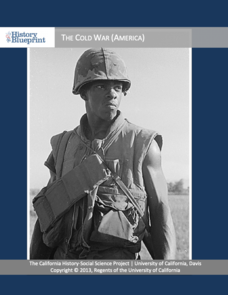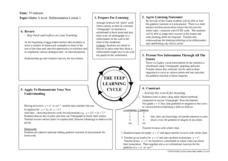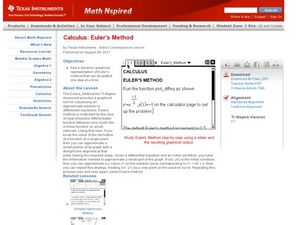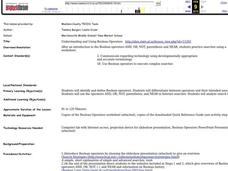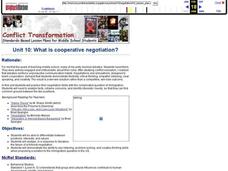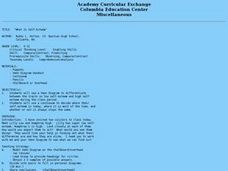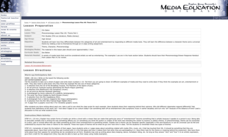Do2Learn
Sharing Space
Interacting with peers can be difficult for many children and adults with autism spectrum disorder. Guide them through a collaborative activity, during which class members come up with self-care solutions to a scenario in which they...
Mascil Project
Drug Concentration
Different medications leave the body at different rates, and how people take them determines their effectiveness. Learners investigate this effectiveness by charting the concentration of a given medication in the body. Using exponential...
State Bar of Texas
Miranda v. Arizona
You have the right to remain silent—but why? Scholars analyze the nature of what has become known as the Miranda Rights. A short video along with paired group work and discussion opens the issue of the rights of the accused upon arrest....
State Bar of Texas
Gideon v. Wainwright
How does a trial begin without a lawyer for the defendant? The 1963 Supreme Court case Gideon v. Wainwright serves as the backdrop for the study of the rights of the accused. Scholars use a short video along with paired discussion and...
State Bar of Texas
Edgewood ISD v. Kirby
Have you ever wondered where the money comes from to pay for your school, teachers, supplies, and building? The 1989 Supreme Court case Edgewood ISD v. Kirby lays a framework for open discussion on the funding of public schools. Using a...
State Bar of Texas
Grutter v. Bollinger
A university decides not to allow a qualified scholar to enter its institution based on skin and gender—but this case is about a white female? The 2003 Supreme Court case Grutter v. Bollinger lays the foundation for open discussion and...
State Bar of Texas
Tinker v. Des Moines
Freedom of speech allows anyone, even those in school, to say and do what they feel—right? The 1969 Supreme Court case Tinker v. Des Moines serves as the backdrop for a study on First Amendment rights. Scholars use a short video along...
University of California
The Cold War (America)
The Cold War—with its roots in World War II—impacts the world today. Using an extensive curriculum, scholars consider its impact through primary sources, including speeches and propaganda, as well as other skills-enhancing activities. An...
EngageNY
Introducing “Comprehending the Calamity”
Some things are beyond comprehension. Scholars read an excerpt from "Comprehending the Calamity," a primary source text about the 1906 San Francisco earthquake. After identifying the gist, pupils complete anchor charts to analyze how the...
EngageNY
Finding the Gist of the Immediate Aftermath: Excerpt of “Comprehending the Calamity”
Brace for the aftershocks! Scholars read an excerpt from a primary source document about the immediate aftermath of the 1906 San Francisco fire and earthquake. Next, pupils complete an anchor chart, analyzing how the author introduces,...
Curated OER
Mass Production Using an Assembly Line
Fifth graders examine the industrial revolution. In this industrialization lesson, 5th graders explore the concept of mass production via the assembly line. They then create an assembly line which demonstrates its costs and benefits...
Curated OER
Mastering Verbs
Second graders will master verbs. In this language arts lesson students will spend extra time working with verbs, and mastering the past, present, and future tenses of commonly used verbs. The students will engage in several activities...
Read Works
Identifying Plot Conflicts
Examine the conflicts in The Great Gilly Hopkins by Katherine Paterson. The strategy outlined here, which could be used for a variety of texts, focuses on the type of conflict, who is involved, and what causes the conflict. Class members...
EngageNY
Developing Reading Fluency: Criteria for Reading Aloud
Third graders develop their reading superpowers in a lesson plan on fluency. After first listening to an audio recording or teacher read aloud, the class works together identifying criteria for fluent reading, focusing on phrasing, rate,...
EngageNY
Developing Reading Fluency: Selecting a Text and Practicing Reading Aloud
Young readers continue to strengthen their fluency skills with a text of their choosing. The teacher first engages the class with an audio recording or read-aloud of a short poem, modeling for children how to read fluently. Next it's...
K20 Learn
Blackout Poetry: Re-Envisioning Writing
Shed light on the beauty of language with a great poetry activity. After learning about Austin Kleon's blackout poetry model, pupils respond to some of his poetry and use it as a model to produce their own. Young writers also share their...
Curated OER
Math- A Level Differentiated Lesson
Students investigate the gradient function of a polynomial and they conduct a class discussion about its meaning. Then students use graphing software in order to examine tangents that can be seen visually to aid those who need visual...
Curated OER
Learning to Analyze Characters
Learners discover writing strategies authors use to enhance characters. In this character writing instructional activity, students are read the Knuffle Bunny books by Mo Willems and analyze the story, characters and settings as...
Curated OER
Euler's Method
Learners identify Euler's method of graphing in this calculus lesson. They approximate values of a function and check their work using EM. They also differentiate equations at an exact point.
Curated OER
Proofreading
Fourth graders explore the proofreading process. They practice proofreading for errors in sentence structure, usage, and mechanics. Students develop strategies for proofreading and differentiate between commonly confused words.
Curated OER
Understanding and Using Boolean Operators
Students identify and define Boolean operators. They differentiate between operators and their intended uses. They use the operators AND, OR, NOT, parenthesis, and NEAR in Internet searches and analyze search results. They use...
Curated OER
What is cooperative negotiation?
Tenth graders differentiate between positions, interests, and values. In this current events lesson plan, 10th graders analyze, in a response to literature, the failure of a fictional negotiation. Students demonstrate the...
Curated OER
What Is Self-Esteem?
Students use a Venn diagram to differentiate between traits of low self-esteem and high self-esteem. They use a continuum to decide where their self-esteem is on a daily basis noting changes.
Curated OER
Phenomenology Lesson Plan #6: Theme Part 1
Pupils practice differentiating between categories of art and entertainment. They also practice telling the difference between character themes and universal themes. They find a text to relate to themselves and write about it.









